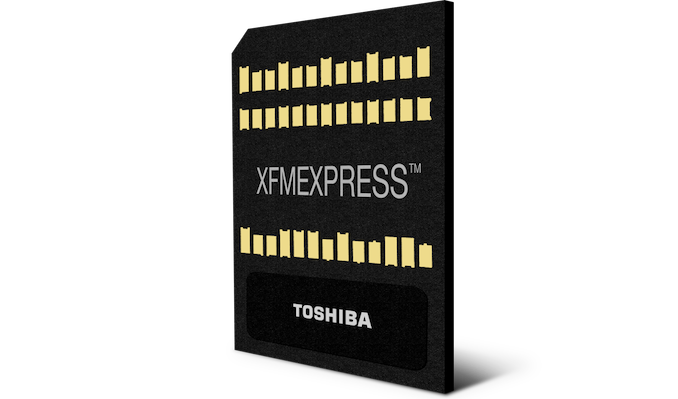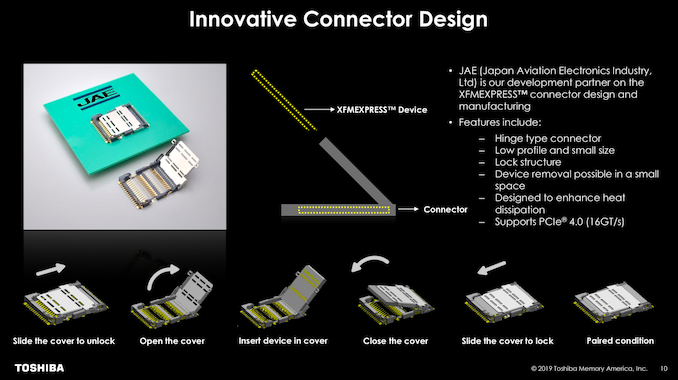Toshiba Introduces New Tiny NVMe SSD Form Factor
by Billy Tallis on August 6, 2019 8:00 AM EST
Today at Flash Memory Summit, Toshiba is debuting a new form factor for NVMe SSDs that is small enough to be a removable alternative to soldered-down BGA SSDs. The new XFMEXPRESS form factor allows for two or four PCIe lanes while taking up much less space than even the smallest M.2 22x30mm card size. The XFMEXPRESS card size is 18x14x1.4mm, slightly larger and thicker than a microSD card. It mounts into a latching socket that increases the footprint up to 22.2x17.75x2.2mm. For comparison, the standard sizes for BGA SSDs are 11.5x13mm with a PCIe x2 interface or 16x20mm with a PCIe x4 interface.
XFMEXPRESS is intended to bring the benefits of replaceable storage to devices that would normally be stuck with soldered BGA SSDs or eMMC and UFS modules. For consumer devices this opens the way for aftermarket capacity upgrades, and for embedded devices that need to be serviceable this can permit smaller overall dimensions. Device manufacturers also get a bit of supply chain flexibility since storage capacity can be adjusted later in the assembly process. XFMEXPRESS is not intended to be used as an externally-accessible slot like SD cards; swapping out an XFMEXPRESS SSD will require opening up the case of the device it's installed in, though unlike M.2 SSDs the XFMEXPRESS socket and retention mechanism itself is tool-less.
XFMEXPRESS will allow for similar performance to BGA SSDs. The PCIe x4 host interface will generally not be the bottleneck, especially in the near future when BGA SSDs start adopting PCIe gen4, which the XFMEXPRESS connector can support. Instead, SSDs in these small form factors are often thermally limited, and the XFMEXPRESS connector was designed to allow for easy heat dissipation with a metal lid that can serve as a heatspreader. Toshiba partnered with Japan Aviation Electronics Industry Ltd. (JAE) to develop and manufacture the XFMEXPRESS connector.











28 Comments
View All Comments
tmnvnbl - Tuesday, August 6, 2019 - link
I can only approve of this. Minimal space, but still serviceable.Samus - Wednesday, August 7, 2019 - link
Couldn't agree more. And I'm excited to see the old school Japanese "over-engineering" at play. They partnered with JAE to make the HINGE. This sucker is aerospace worthy.AdditionalPylons - Tuesday, August 6, 2019 - link
I'd love for this to go into Apple devices, but I'm not expecting so, since they'd rather retain the insultingly high upgrade prices to boost the margins.rocky12345 - Tuesday, August 6, 2019 - link
If Apple was to do this they probably would take this change it slightly and say they invented it. But do they not prefer having it soldered onto the main board so you are forced to upgrade the whole system. I am not 100% sure on that since I do not own anything Apple at all.MASSAMKULABOX - Thursday, August 8, 2019 - link
No red will take this call it the x10, hand paint it red and apply an x10 price uplift for next generation storage and "innovative research"umano - Sunday, August 11, 2019 - link
Or they will sell a 16gb version at 59$ and 64gb at 389$, 128gb 879$ and 1 tb at 8.99e12RadiclDreamer - Tuesday, August 6, 2019 - link
Apple still sells spinning disk in "premium priced" imacs. They wont go to SSD without a major uptick in pricing until they absolutely have to.Lord of the Bored - Wednesday, August 7, 2019 - link
On their laptops, they went from a custom version of mSATA toa custom version of M.2 to
solder the flash directly onto the motherboard and include a diagnostic port for recovering data from a failed system to
as above, but with no way to recover data from a failed system.
DanNeely - Tuesday, August 6, 2019 - link
Unless it's just a more compact or cheaper physical socket I'm not sure what this actually offers vs smaller form factors in the m.2 spec? While current consumer modules are all 22mm wide, 16 and 12mm widths are also in spec, as is a 16mm length. At the smallest end a 12x16mm m.2 sdd would be significantly smaller in area than this SD derived implementation, although I suppose this might win on overall socket/drive volume or z height.https://kb.sandisk.com/app/answers/detail/a_id/209...
Billy Tallis - Tuesday, August 6, 2019 - link
Most of the smaller sizes defined by the M.2 spec are actually soldered-down LGA or BGA modules. The only thing smaller than 22x30 that's still removable is 16x30, which is literally the 22x30 card form factor with 5.5mm sliced off—including some of the pins required for PCIe x4.